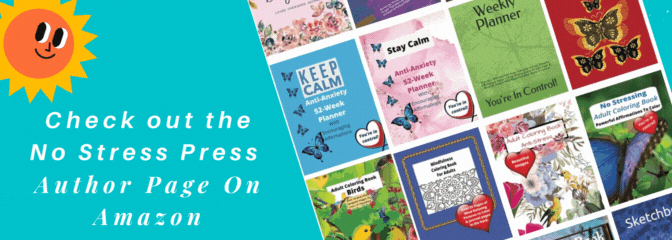Top 5 Reasons Stretching Reduces Stress

- You’re more relaxed.
- You’re more mindful.
- Your blood pressure is lowered.
- Improved circulation throughout your body.
- Negative thoughts are reduced.

Everyone experiences stress in their lives. Stress can be both good and bad. The “good” stress is called eustress. An example of eustress would be getting excited about buying something you really want or doing something really want to do. You feel yourself becoming more energetic and joyful. Eustress is beneficial because emotionally, the positivity of contentment is powerful, we become inspired, motivation is easier to achieve, and positive flow increases self-efficacy and confidence. People become more resilient in their thoughts and believe they can reach goals. The “bad” stress, if experienced for prolonged periods of time without interruption, may cause physical, psychological, and emotional damage.
Therefore, the No Stress Press was created. The world (which includes all of us) could use more positive strategies and ideas to reduce “bad” stress. On the website you’ll find blog posts, and recommendations to help reduce chronic stress, along with surefire techniques that will help anyone that wants to be calmer and more relaxed to do so.
Today, the tool for discussion is stretching.
Stretching is the perfect type of exercise because everyone can do it regardless of their fitness level. It is a good start for people who don’t exercise, and those who already exercise a lot. Everyone can find satisfaction in stretching.
Get Tips & Ideas
Quarterly Newsletter March, June, September & December
Adult Coloring Is Therapeutic
So, what happens when we stretch our bodies?
- We make our bodies and thoughts slow down. We can enter a meditative state and proactively reduce our mental stress in just a few minutes.
- We’re moving all muscle groups, from our face to our limbs to our extremities.
- We find the areas in our bodies that are stressed or tense and need more stretching.
- We improve our balance, posture, and spinal alignment.
- We become more aware of our minds and our bodies.
- We become more agile and nimble.
- We become more athletic, and for many of us we move from a more sedentary lifestyle to a more active one.
These are benefits that will change our lives for the better, that will improve our concepts of ourselves and the way we see others that are on this journey we call life.
Here are a few things we should remember when starting a stretching routine.
- Whether a person is accustomed to stretching and can do a full split or is new to this exercise, we should all avoid over-stretching. Please remember to never stretch to the point of pain or discomfort. It may be tempting to “push” ourselves, but an over stressed muscle or aggravated joint can keep you up at night.
- This next tip is about taking time with ourselves. Sometimes, we forget to show our bodies love. Loving our legs, arms, knees, backs, shoulders, necks, and every other part of us is key to building good confidence. Therefore, it is very important to go slow. Going slowly and evenly will ensure that we don’t hurt ourselves and/or set ourselves back because we need time to heal. Let’s skip the injuries and do ourselves right by doing our stretching slowly and even!
- Please avoid bouncing or jerking while stretching. This is another way to cause an accidental injury. If a muscle is pushed beyond its ability, you’re going to know about it.
Adult Coloring is another way to reduce stress.
Adult coloring is scientifically proven to relieve stress. The relaxation that it provides lowers the activity of the amygdala, a basic part of our brain involved in controlling the emotion that is affected by stress.”. In simplest terms, coloring has a de-stressing effect because when we focus on a particular activity, we focus on it and not on our worries.
- Become mindful of the gift of the present.
- Reduce negative and unwanted thoughts.
- Explore your own creativity.
- Reduce social media and blue light consumption.
A Special Word About Gratitude
Gratitude lowers stress thereby lowering the levels of cortisol and adrenaline the adrenal glands produce. In a study conducted by Kyeong Sunghyon and associates on the effects of gratitude meditation on heart rate, it was found to lower heart rate.
Writing thoughts of gratitude and appreciation on paper also offered a better mental outcome over an initial 4 weeks and 12 weeks after the study’s conclusion according to the study done by the Joel Wong and associates.
Gratitude increases mental strength. For years, research has shown gratitude not only reduces stress, but it may also play a major role in overcoming trauma. A 2006 study published in Behavior Research and Therapy found that Vietnam War veterans with higher levels of gratitude experienced lower rates of post-traumatic stress disorder. A 2003 study published in the Journal of Personality and Social Psychology found that gratitude was a major contributor to resilience following the terrorist attacks on September 11. Recognizing all that you must be thankful for —even during the worst times—fosters resilience.

Conclusion
When you lower stress, you lower your body’s fight or flight response. That response includes chemicals produced in the adrenal glands called cortisol and adrenaline. These chemicals are short-term responders to environmental stress. If you stay in a stressed state your body becomes desensitized to the effects of the chemicals. Chronic stress makes people more susceptible to illness. Gratitude has been clinically shown to reduce cortisol, thereby reducing inflammation, heart rate and blood pressure.
Remember, no one thing is going to bring wholeness. We must dedicate ourselves to loving ourselves enough to pay attention to how we feel. Then we must make feeling better about ourselves the most important thing we do!
Thank you for reading this post!
Be blessed!



